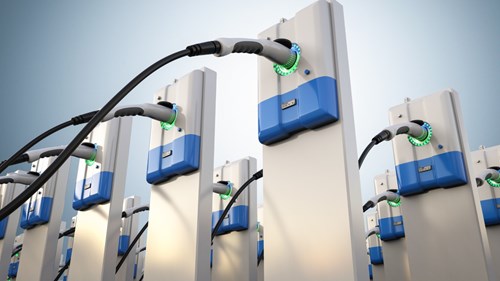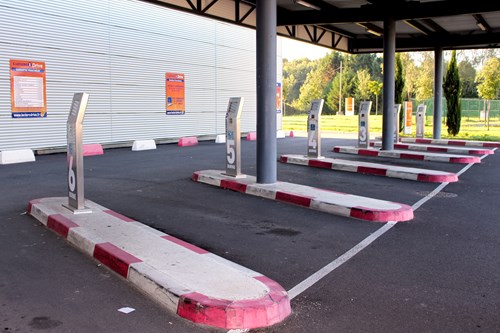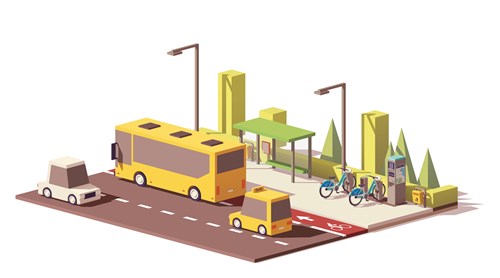
As I write this blog, sun blazing outside and desk fan buzzing in my ear, I’m glad that silly season is drawing to a close. That said, there have still been plenty of newsworthy parking headlines out there for the July and August recap, with EV charging, mobility hubs, solar parking, and changing retail trends all piquing my interest.
Reducing EV Charging Range Anxiety and Delivering a Seamless Electric Lifestyle

With an estimated 16.5 million electric cars on the road and more coming thanks to the commitment of major auto manufacturers, there is no doubt that we are heading into an EV revolution. Yet, whilst automakers are making great strides in manufacturing bigger batteries, range anxiety remains a major setback for EV adoption. So, if the EVs themselves are not to blame, where is the problem?
Finding convenient, accessible, fast, and working chargers is still a challenge. Oftentimes chargers are difficult to access and pay for, broken, slow, or simply non-existent across large geographical areas. As a result, many EV drivers are not taking cross-country trips but instead staying within 100 miles of their homes. Of course, with governments pushing for mass EV adoption, charging infrastructure and accessibility will need to improve, otherwise range anxiety will perpetuate, regardless of the advances that automakers make.
In terms of growing the EV infrastructure, there is certainly a lot of work to be done. For instance, there are currently around 225,000 EV charging stations across Europe, however, 70% are located within just three countries - the Netherlands, France, and Germany totaling just 23% of the EU’s total surface area. And whilst the EU aims to install 1.3 million public chargers by 2025, and close to 3 million by 2030, according to ACEA, at least 6 million are needed to achieve the EU’s goal of cutting 50% of CO2 emissions by 2030.
Meanwhile, in the United States, there are just 122,000 Level 2 and DC fast-charging connector charging ports across the country, with almost one-third located in just one state - California. However, there is hope, with municipalities such as Los Angeles introducing legislation that requires EV charging minimums for off-street parking facilities. In Vancouver, a similar scheme will see 30% of gas stations, and 40% of parking lots install chargers by 2030.
Once installed, these EV chargers also need to be easily accessible to drivers, which means updating currently inaccurate POI information and streamlining the payment process. Many EV chargers are located within parking facilities, where GPS navigation is not possible, but indoor mapping technologies, such as those used by Parkopedia can help direct EV drivers to the parking facilities and then directly to the chargers themselves.
And, another easy way to make the existing infrastructure easily accessible is through wallet-friendly payment solutions. As an EV driver, taking a long trip can involve downloading numerous charging apps, applying for various cards, and preparing numerous other payment methods. A solution such as CPI’s Alio Pro can accept the full range of payment options and even offer drivers a reward or incentive to park again.
Keeping Ahead of Retail Trends

As we look for convenience in our everyday lives the way in which we go about daily tasks is changing. I’m sure many of us would happily forego the weekly shop and gladly do away with those quick dashes to the supermarket on the way home from work. Well, thanks to Click & Collect services, shoppers no longer need to waste time walking up and down the aisles, instead, they can place an order online and collect at a time that is convenient for them.
But what does this mean for supermarket parking? As many shoppers are likely still using supermarkets in the traditional way it is important that parking spaces are reserved for Click & Collect customers so that they have a guaranteed spot when they collect their orders. By providing a zone, with space-specific pick-up points, parking facilities can offer the ultimate convenience for Click & Collect customers.
In France, Innova and Leclerc have developed a fully-integrated Click & Collect system. Shoppers simply place their orders online and provide their license plate numbers. Once they arrive at the parking facility the license plate recognition software detects the customer’s vehicle and provides access to the Click & Collect zone. From here, an informative panel directs the driver to the correct space where they can collect their purchase.
Integrating such systems and reworking existing parking technologies will certainly become more commonplace as parking facilities continue to evolve into mobility hubs that offer a multitude of amenities.
Mobility Hubs – Logistics, Cycling, and Car-sharing
Speaking of mobility hubs and convenience in everyday life, Q-Park has been busy working on several projects to transform parking facilities into vital instruments to help boost urban accessibility, sustainability, and livability.
The installation of PostNL lockers in 15 parking garages across the Netherlands, in cities including Amsterdam, Rotterdam, and The Hague, has made it possible for customers to deliver or collect their parcels 24/7. The inclusion of logistics solutions is helping Q-Park transform single-use parking facilities into community focal points, benefitting not just drivers but local residents too.
In London, Q-Park has teamed up with Spokesafe to provide secure bicycle parking and e-bike charging at the heart of China Town. By offering bike parking, not as an afterthought but as a secure facility, more commuters will be encouraged to cycle, helping municipalities reduce urban congestion and the harmful emissions that come with it.
And, throughout the UK and Europe, Q-Park is working with car-sharing businesses to help them prepare for Low Emission Zones and mass EV adoption. By providing places in their mobility hubs, Q-Park helps car-sharing businesses find a central location that is well connected to the wider mobility ecosystem.
Solar Farms – A Sustainable New Future for Parking?

If you’ve seen our recent blog post, Eight Surprising Facts About Parking, then you will know that a huge amount of land is devoted to parking – as much as 68% in city centers. So what would happen if we transformed this vast amount of underutilized space into something more ecologically responsible? Could we transform our parking lots into solar farms to help meet our growing energy needs and reduce our reliance on fossil fuels?
Taking Rutgers University and Evansville Regional Airport as their examples, ROKER explored the benefits of solar parking structures and the development of parking facilities into microgrid systems. According to current studies, a typical five-acre lot, equipped with solar canopies, could produce enough power to charge over 100 electric vehicles. For one major US retailer, researchers estimated that through this innovation their parking facilities alone could generate the equivalent of 11 large power plants and give 90% of Americans access to a charging station within a 15-minute drive from their home, further helping the EV revolution.
So, as we move towards a greener and more sustainable future it seems as though the parking industry has several key roles to play – from helping to generate greener energy, to supporting EV adoption and transforming single-use facilities into connected mobility hubs.





